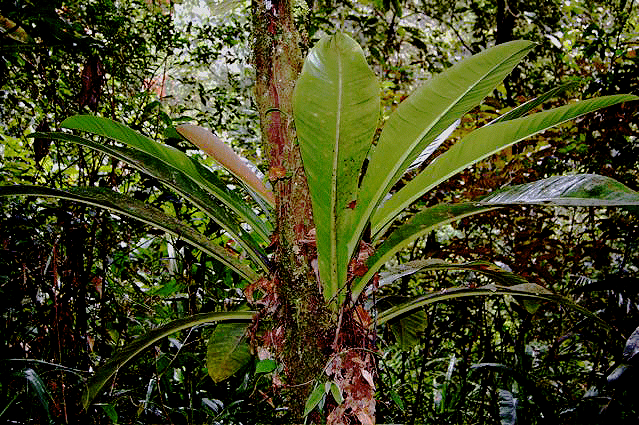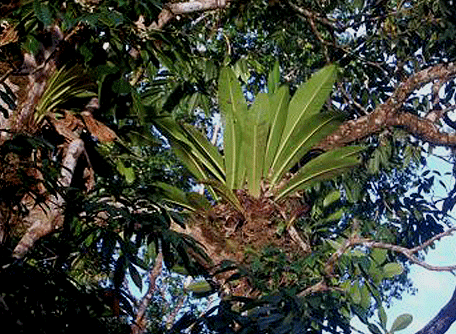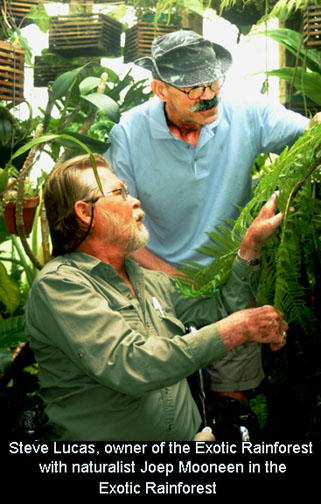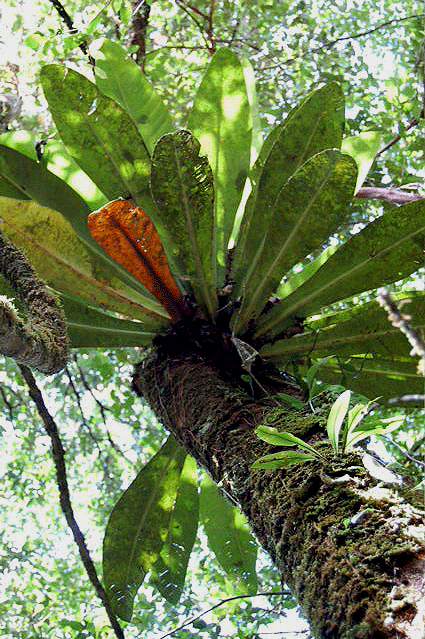![]()
Aroids and other genera in the Collection
Take the Tour Now?
Orchids
The
Exotic Rainforest
Plants in
the Exotic Rainforest Collection
Images on this website are copyright protected. Contact us before attempting to reuse.
In depth information on how to grow Philodendron species, Click this Link
Within our collection we have many species of Philodendron. If you are seeking other photos, click this link
Philodendron insigne Schott

Philodendron calophyllum Brongn. ex Linden & André
Philodendron haematinum R.E. Schult.
Resembles Dieffenbachia paludicola N.E. Br. ex Gleason
 The species ranges from
near sea level as well as from 100 meters to 1100 meters (330 to
3600 feet) and is commonly observed at lower
elevations. As one of approximately 1,000 known Philodendron
species,
Philodendron insigne is an aroid and was originally published to science in
1856.
The species ranges from
near sea level as well as from 100 meters to 1100 meters (330 to
3600 feet) and is commonly observed at lower
elevations. As one of approximately 1,000 known Philodendron
species,
Philodendron insigne is an aroid and was originally published to science in
1856. According to the field notes of aroid botanist Dr. Thomas B. Croat Ph.D., P.A. Schulze Curator of Botany of the Missouri Botanical Garden in St. Louis, MO, Philodendron insigne Is an epiphytic species known to grow attached to a tree. The botanical definition of an epiphyte (ep-a-FIT) is a plant that grows upon another plant. Often found well up in the rain forest canopy, in the accompanying photographs by Dutch naturalist Joep Moonen (pronounced yupe), Philodendron insigne is sometimes seen completely encircling the trunk of a tree but may also grow attached to a branch.
The
species frequently grows in lowland rain forest near sea level. Joep recently explained in a personal email, "If
i go with my boat, they are not too difficult to collect."
However, Dr. Croat notes
in his field notes the species can also be found growing as a
terrestrial form. However, Joep noted he has personally never
seen the phenomenon in Suriname, French Guiana or Amapa.
 In appearance resembling Philodendron
linnaei Kunth. In Dr. Croat's treatment of Philodendron linnaei, he
wrote "It is most easily confused with P. insigne, which has a
similar habit, short petioles and similar long-pedunculate
inflorescences with reddish spathe tubes." Philodendron linnaei is
often seen in the same regions of South America. According to Joep, another species that looks
exactly like P. insigne is Dieffenbachia paludicola.
Joep wrote,
"i thought this was Philodendron insigne growing in wet marshy
places until i found it in flower"
In appearance resembling Philodendron
linnaei Kunth. In Dr. Croat's treatment of Philodendron linnaei, he
wrote "It is most easily confused with P. insigne, which has a
similar habit, short petioles and similar long-pedunculate
inflorescences with reddish spathe tubes." Philodendron linnaei is
often seen in the same regions of South America. According to Joep, another species that looks
exactly like P. insigne is Dieffenbachia paludicola.
Joep wrote,
"i thought this was Philodendron insigne growing in wet marshy
places until i found it in flower"
Aroid expert Leland Miyano observed, "Philodendron insigne grows much larger than Philodendron linnaei and proportionately, the leaf blades are about twice as wide in the former if similar sized leaves are compared. The rosette habit is much more pronounced in Philodendron insigne as Philodendron linnaei tends to loosely form a spiral and often it forms only a partial rosette. The leaves of Philodendron linnaei are more acuminate at the tips and slightly re-curve. In this respect, Philodendron insigne has leaf tips that appear blunt in comparison. Philodendron insigne has new emergent leaves that blush with red and new leaves may also have a bright red edge. Philodendron linnaei has new leaf growth in shades of green."
 leaves grow from the internodes.
However, within aroid species an inflorescence may also be
produced from an
internode. Once a new leaf is produced, it is surrounded by a
sheath-like structure known as the cataphylls.
The
cataphylls are bract like modified leaves that surround a new
leaf and whose purpose is to protect the newly emerging leaves
as they develop.
The
leaves may also be deciduous and
drop from the plant during the season of the year when rain is
not plentiful.
leaves grow from the internodes.
However, within aroid species an inflorescence may also be
produced from an
internode. Once a new leaf is produced, it is surrounded by a
sheath-like structure known as the cataphylls.
The
cataphylls are bract like modified leaves that surround a new
leaf and whose purpose is to protect the newly emerging leaves
as they develop.
The
leaves may also be deciduous and
drop from the plant during the season of the year when rain is
not plentiful. internod runners that form
new rosette form plantlets. Philodendron insigne never does
this and grows so slowly that if it forms a vine these must be
quite old."
internod runners that form
new rosette form plantlets. Philodendron insigne never does
this and grows so slowly that if it forms a vine these must be
quite old."The images on this page are the Copyright property of naturalist Joep Moonen in French Guiana. You must seek permission before attempting to duplicate any image! If you enjoy spending time in a rain forest filled with exotic creatures and extremely rare exotic plant species Joep Moonen also enjoys introducing people like you to the rain forests of northeast South America. The Emerald Jungle Village website can be found at http://home.planet.nl/~gumamaus/
For eco-tour information contact Joep Moonen at EmeraldJungleVillage@wanadoo.fr
If you are seeking information on
other rare species, click on "Aroids and other genera in the Collection" at the top and look
for the
Want to learn more
about aroids?
Join the
International Aroid Society:
http://www.exoticrainforest.com/Join%20IAS.html